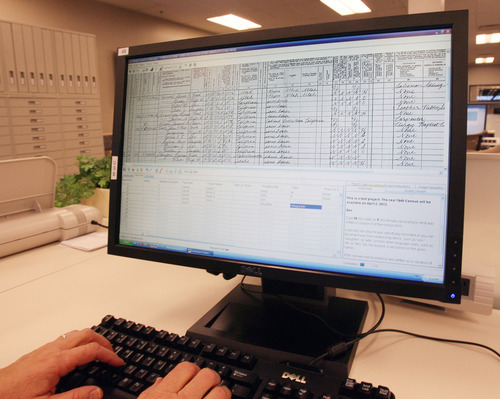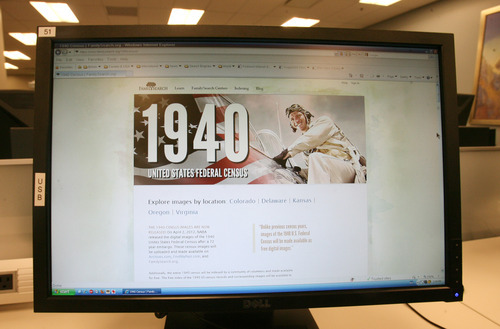This is an archived article that was published on sltrib.com in 2012, and information in the article may be outdated. It is provided only for personal research purposes and may not be reprinted.
Joyce Pruhs hasn't seen the newly released 1940 U.S. Federal Census documents, but already she is imagining the lives of Delaware men on the cusp of World War II as she repeatedly refreshes her computer screen at the FamilySearch Library in Riverton.
Along with hundreds of thousands of other volunteer indexers, she's waiting for the digital images that the National Archives had announced would be released Monday. Delaware was to be first, but by midafternoon, Pruhs hadn't been able to look at anything but a dummy sample of a 72-year-old neatly handwritten census tally from San Francisco.
"We're all anxious," she says. "We were all hyped that we could get on at 1 o'clock."
Legions of volunteers will sit at computers, stand with tablets or tap smartphones to download batches of the vintage forms, then type into a database the information that will make up the index. Without it, the record of 132 million souls in America would remain an amorphous mass of documents that can't be searched in an organized way.
This is the first time the National Archives and Records Administration has released the images in digital form, online, for free.
The National Archives site was nearly paralyzed by the 22 million hits it received Monday morning, but spokeswoman Susan Cooper told The Associated Press that the government was adding "a lot more servers, a lot more muscle to the website."
The 1940 census is the largest, most comprehensive and most recent record set available that records the names of those who were living in the United States at the time. As the National Archives points out, "tens of millions of people living in the United States in 1940 are still living today, making this a record set that connects people with recent family records."
Organizers of the 1940 U.S. Census Community Project hope to have the entire index completed and online by Sept. 30. Each name will be indexed by two people. If there are discrepancies, the software catches them and forwards the work to arbitrators — volunteers with lots of indexing experience.
Pruhs, an arbitrator who has so far indexed 84,695 records from censuses taken since the 19th century, is especially keen to look in on families she last glimpsed when she indexed the 1930 census. That project wound up last year. She wants to find out how the children turned out, if they lived, if they might be soldiers by 1940, when the census was tallied between January and June. She's already envisioning their stories.
The families have gone through the worst of the Great Depression and watched the rise of Adolph Hitler and Benito Mussolini, but haven't seen Hideki Tojo rise to power as Japan's minister of war and then prime minister. They answered questions about where they lived, how old they were, how much school they had attended, how many children they had, who they married, what they were doing for work and where they were in 1935.
Pruhs knows that the 1950 census, to be released in 2022, will show that many of the men died in the bloody war. But in 1940, she says, "at least we've got them at home with their wife, their children or with their parents."
Federal law mandates that the census forms be withheld from scrutiny for 72 years. In 2002, the 1930 census was released, but like all those that have come to public light since 1790, the images were available for sale to mostly commercial entities that offered them to paying subscribers.
Cedar Hills resident and Utah Genealogy Association president Janet Hovorka says the genealogy world is abuzz about 1940. The indexing effort, she says, "is a wonderful project that never has been done before. Different entities have indexed other censuses, but never has there been a community effort like this."
Technology that was just coming into wide use in the early part of this decade now is available to everyone, just about anywhere, on multiple platforms.
"It's so much easier now to get the word out and to make it a group project," Hovorka says. "It's a whole different ball game than it was 10 years ago."
Paul Nauta, spokesman for FamilySearch International, reckons the 3.85 million images from 1940, each of which can hold up to 50 name records, would be ready for viewing by Monday evening.
"This is a total Internet-based national service project," Nauta says. "It's a behemoth task, a pretty cool way to volunteer time to something that's very historic, very significant."
Nauta says the egalitarian effort wouldn't won't put commercial sites out of business. Even after this project is done, he says, only about 20 percent of U.S. vital records — births, deaths, marriages, land deeds, court actions, all genealogically significant — will be online.
Melissa Garrett, spokeswoman for Provo-based Ancestry.com, says the release has been only good for her company. It picked up its own copy of the census at midnight and also had pages flowing online Monday. It expects to have a fully indexed version available before the end of the year, with free access through 2013, a company statement says.
"Our site, compared to a regular day, has increased 170 percent," Garrett says. "We've seen a lot of interest." —
The popular 1940s
The National Archives and Records Administration has pages from the 1940 U.S. Federal Census flowing onto its site at http://1940census.archives.gov/. While intense demand for the images overwhelmed the site early Monday, The Associated Press reported that the Archives were adding servers to speed up response. —
About the 1940 Census
The 1940 U.S. Federal Census is the largest, most comprehensive and most recent record set available that records the names of those who were living in the United States at that time.
The digital census images are being uploaded and will be available on Archives.com, FindMyPast.com and FamilySearch.org. Delaware's records are first up. The entire 1940 census will be indexed by a community of volunteers and made available for free to the public.









